
Effective Practices for Infection Prevention Audits and Control
"Learn about the importance of audits in infection prevention and control, including key points, audit teams, healthcare-associated infections, the PDSA cycle, audit methods, and basic principles of care bundles. Discover how audits can improve healthcare service quality and reduce risks." (271 characters)
Download Presentation

Please find below an Image/Link to download the presentation.
The content on the website is provided AS IS for your information and personal use only. It may not be sold, licensed, or shared on other websites without obtaining consent from the author. If you encounter any issues during the download, it is possible that the publisher has removed the file from their server.
You are allowed to download the files provided on this website for personal or commercial use, subject to the condition that they are used lawfully. All files are the property of their respective owners.
The content on the website is provided AS IS for your information and personal use only. It may not be sold, licensed, or shared on other websites without obtaining consent from the author.
E N D
Presentation Transcript
Audits in Infection Prevention and Control Dr. Ved Prakash (Infection Control Officer) Professor & Head PG Department of Microbiology
Key points Audit means checking practice against a standard. It examines the actual situation and compares it to written policies or another benchmark. Audit can help to improve health care service by providing a blame-free mechanism for changes in practice. It can also be used for risk assessment, strategic planning, and root cause analysis.
An audit team is essential to carry out a proper audit through good planning, performance, and feedback of results. Audit results may be provided to others through various types of reporting.
Introduction Healthcare-associated infections are generally related to multiple factors. Prevention of these infections depends on daily vigilance and implementation of infection prevention and control (IPC) practices. These practices are outlined in written guidelines, policies, and procedures.
Audit Method Initially it is probably worth selecting a few areas to audit, preferably those that are most important to the organisation. These may include high-risk areas highlighted through surveillance results or occurrence of outbreaks.
An effective audit should include a description of the physical layout; review of traffic flow, protocols and policies, supplies and equipment; and observation of appropriate IPC practice.
Basic Principles Bundles A bundle is a multi-model structured way of improving processes of care and patient outcomes. A bundle is a collection of processes needed to effectively and safely care for patients undergoing particular treatments with inherent risks. Several interventions are bundled together and, when combined, significantly improve
patient care outcomes. Bundles are helpful and have been developed for ventilator- associated pneumonia, catheter-associated urinary tract infection, and central line- associated bloodstream infection prevention.6
A bundle pack includes: 1. A statement of commitment for the clinical team to sign. 2. A cause-effect chart describing the evidence for optimal practice and used also for root cause analysis of non-conformities, in reference to the standards. 3. Standard operating procedures for the bundle including specific criteria. 4. A data collection sheet. 5. Explanation of the bundle to the clinical staff (e.g., group discussion, slide presentation)
Types of Audits in Hospital Infection Control Process Audits : To assess right polices & procedures to prevent infection Outcome audits : To assess actual rates of infection in the Hospital. Observational Audits : It involves watching staff members to see, if they are following infection control procedures correctly
What are to be audited 1. Hand hygiene (readiness and practice; supplies such as soap, paper towel, alcohol-based products). 2. Use of standard precautions/routine practices. 3. Use of isolation/precautions. 4. Use of personal protective equipment. 5. Monitoring of sterilisation equipment.
6. Cleaning, disinfection, and sterilisation of reusable equipment and devices, such as bronchoscopes and surgical instruments. 7. Health care environment cleaning. 8. Haemodialysis practices, equipment, facility.
9. Operating room IPC practices, asepsis and preoperative antisepsis, traffic control, patient skin preparation, hair removal, surgical scrub, and prophylactic antibiotics. 10.Practice and medical device reprocessing in clinics and physician offices. 11.Occupational health issues, such as, sharps injuries/needle sticks, vaccination rates. 12. Outbreak management.
How to Report Audits Once the audit is completed, a draft, detailed report must be written and reviewed with management and key staff in the audit area before it is finalised and distributed. The report should include information on why the audit was performed, method used, findings, and recommendations. Compliance data should be included as appropriate.
Reporting of audits could be in the form of: Weekly reports: Providing rapid feedback on incidental issues while they are still fresh (e.g., during outbreaks or after occupational sharp injuries). Monthly reports: A monthly report should include sections about surveillance, audit results, education, training, and consultations. Quarterly reports: These are formal reports including recommendations and management of issues.
Annual reports: A summary of audits carried out during the year and the resulting improvement or changes during the rapid and annual audit plans, illustrated as appropriate with graphs. Staff must learn to appreciate that the intent of audits is to promote good practice, improve patient care, and ensure safety. A key person must be identified in each area to help facilitate implementation of any recommendations within a specified time.
An Annual Audit Plan Jan Feb Mar Apr May Jun Jul Aug Sept Oct Nov Dec MRSA admission screening Hand hygiene Antimicrobial policy Disposal of sharps Disinfection policy Central processing policy Aseptic techniques in operating room Surveillance
Summary (Take Home Message) Health care requires an increased emphasis on the use of audits to measure the implementation of policies and procedures relating to IPC practices. Development of audit plans based on a risk assessment strategy, preparation of the audit team, tailoring of the audit method, and audit assessment of knowledge are pillars of internal audits in health care organisations.






















